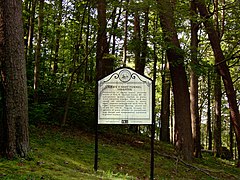Hawk's Nest incident

Historical marker "Hawks Nest Tunnel Disaster"
|
|
| Date | 1931 |
|---|---|
| Location | Gauley Bridge, West Virginia |
| Coordinates | 38°07′20″N 81°07′42″W / 38.12222°N 81.12833°WCoordinates: 38°07′20″N 81°07′42″W / 38.12222°N 81.12833°W |
| Cause | occupational silicosis |
| Deaths | 476 to 5,000 (estimated) |
The Hawks Nest Tunnel disaster was a large-scale incident of occupational silicosis as the result of the construction of the Hawks Nest Tunnel near Gauley Bridge, West Virginia, as part of a hydroelectric project. This project is considered to be one of the worst industrial disasters in American history.
To generate electricity for a plant downstream at Alloy, Union Carbide's Kanawha and New River Power Company subsidiary decided to divert the New River to improve its power generation ability. Beginning in 1927, its contractor Rinehart & Dennis began construction of the 3-mile (4.8 km) tunnel carrying the river under Gauley Mountain. A dam was constructed immediately below Hawks Nest to divert most of the New River flow into the tunnel. It then re-enters the river near Gauley Bridge leaving a section known as "the Dries" in between.
During the construction of the tunnel, workers found the mineral silica and were asked to mine it for use in electroprocessing steel. The workers were not given any masks or breathing equipment to use while mining, although management wore such equipment during inspection visits. As a result of the exposure to silica dust, many workers developed silicosis, a debilitating lung disease. A large number of the workers eventually died from silicosis, in some cases as quickly as within a year.
There are no definitive statistics as to the death toll from the Hawks Nest disaster. According to a historical marker on site, there were 109 admitted deaths. A Congressional hearing placed the death toll at 476. Other sources range from 700 to over 1,000 deaths amongst the 3,000 workers. Many of the workers at the site were African-Americans from the southern United States who returned home or left the region after becoming sick, making it difficult to calculate an accurate total.
A nearby West Virginia Historical Marker at Hawks Nest State Park reads:
...
Wikipedia
